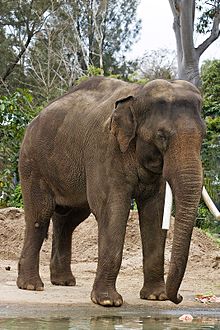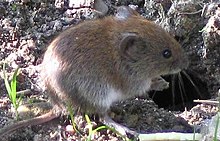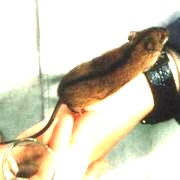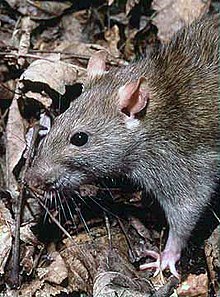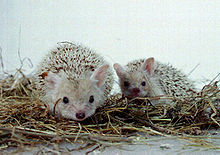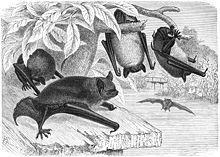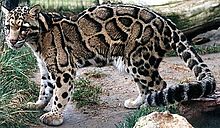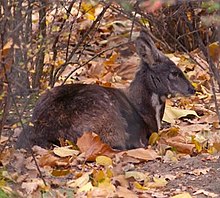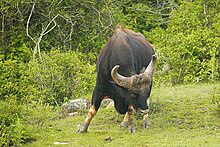중국의 포유동물 목록
List of mammals of China
이것은 중국에서 기록된 포유류의 목록이다.중국에는 495종의 포유류가 있으며, 이 중 13종이 멸종위기에 처해 있고, 24종이 멸종위기에 처해 있으며, 47종이 취약하며, 7종이 거의 멸종위기에 처해 있다.중국에 등재된 종 중 한 종은 더 이상 야생에서 찾을 수 없다.[1]
국제자연보전연맹(International Union for Natures)이 평가한 각 종의 보존 상태를 강조하기 위해 다음과 같은 태그를 사용한다.
| EX | 사멸된 | 마지막 사람이 죽었다는 것은 합리적 의심의 여지가 없다. |
| EW | 야생에서 멸종된 | 사육되거나 이전 범위를 훨씬 벗어난 귀화인구로만 알려져 있다. |
| CR | 심각한 멸종위기에 처해 있음 | 그 종은 야생에서 곧 멸종될 위험에 처해 있다. |
| EN | 멸종위기에 처한 | 그 종은 야생에서 멸종될 위험이 매우 높다. |
| VU | 취약한 | 그 종은 야생에서 멸종될 위험이 높다. |
| NT | 근위협박 | 이 종은 멸종위기에 처한 것으로 분류되는 어떤 기준도 충족시키지 못하지만, 앞으로 그렇게 될 것 같다. |
| LC | 최소 관심사 | 종에 대한 현재 식별 가능한 위험은 없다. |
| DD | 데이터 부족 | 이 종에 대한 위험을 평가하기에 불충분한 정보가 있다. |
일부 종은 이전의 기준을 사용하여 평가되었다.이 시스템을 사용하여 평가한 종은 거의 위협받고 가장 덜 우려되는 범주가 아닌 다음과 같은 범주가 있다.
| LR/cd | 낮은 위험/보존률에 따라 다름 | 보존 프로그램의 초점이 되었고 프로그램이 중단되었다면 더 높은 위험 범주로 이동했을 수 있는 종. |
| LR/nt | 위험 감소/위험에 가까운 위험 | 취약한 종으로 분류되는 것에 가깝지만 보존 프로그램의 대상은 아니다. |
| LR/lc | 위험/최저 우려 감소 | 식별 가능한 위험이 없는 종. |
순서: 사이렌시아(매너테이프와 듀공)
사이레니아는 강, 강, 강, 연안, 늪, 해양 습지에 서식하는 완전 수생 초식 포유류의 주문이다.네 종 모두 멸종 위기에 처해 있다.
순서: 프로보스상과(코끼리)
코끼리는 3개의 살아있는 종으로 구성되어 있으며 살아있는 육지 동물 중 가장 크다.
순서: 스칸덴시아(트리스 스크류)
나무나루는 동남아시아의 열대우림이 원산지인 작은 포유동물이다.나무나루라고 불리지만, 그들은 진정한 뾰루지가 아니며 모두 목가적인 것은 아니다.
순서: 영장류
영장류에는 인간과 그들의 가장 가까운 친척인 여우원숭이, 로리소이드, 원숭이, 유인원이 포함되어 있다.
- 하위 순서:스트렙시리니
- 인프라오더: 여우원숭이목
- 슈퍼 패밀리:로리소아상과
- 가족: 로리스과(요람, 야생동물)
- 속: Nycticebus
- 벵골 슬로우 로리스, N. 벵골렌시스 EN[5]
- 크산토닉티스부스속[6]
- 속: Nycticebus
- 가족: 로리스과(요람, 야생동물)
- 슈퍼 패밀리:로리소아상과
- 인프라오더: 여우원숭이목
- 하위 순서:하플로리니
- 인프라 순서:시미오목
- 파보더: 카타르히니
- 슈퍼 패밀리:큰곰팡이상과
- 슈퍼 패밀리:호미노상과
- 가족: 히로바티과(기본)
- 속: 훌록
- Western Hoolock Gibbon, H. Hoolock EN 유무 불분명[12]
- 동부 훌록긴팔원숭이, H. Leuconedys VU[13]
- 스카이워커 훌록 기브본, H. 톈싱 EN[14]
- 속: 현로바테스
- 속: 노마스쿠스
- 검은볏긴팔원숭이, N.콘콜러 CR
- 하이난 검은 볏긴팔원숭이, N. 하이난너스 CR[16]
- 흰치크 볏긴팔원숭이, N. leucogenys
- 동부 흑갈색 볏긴팔원숭이, N. nasutus CR
- 속: 훌록
- 가족: 히로바티과(기본)
- 파보더: 카타르히니
- 인프라 순서:시미오목
순서: 로덴티아(로덴트)
설치류는 포유류의 40% 이상이 포유류로 가장 많은 수를 차지한다.위턱과 아래턱에는 두 개의 근절이 있는데, 지속적으로 자라나 갉아먹어 키가 작아야 한다.대부분의 설치류는 작지만 카피바라의 무게는 45kg(99lb)까지 나간다.
- 하위 순서:히스트리코그나티
- 하위 순서: 스쿠로그나티
- 가족: 카스토리아과(비버)
- 패밀리: 시커러과(다람쥐)
- 하위가족: 라투피네
- 아과: 시루리나과
- 부족: 스쿠리니
- 부족: 프테로미니
- 속: 애레테스
- 그루브발톱날다람쥐, 애레테스 멜라노프테루스
- 속: 벨로미스
- 털북숭이 날다람쥐, 벨로미스 피어소니
- 속: 실로페테스
- 속: 페타우리스타
- 붉은색과 흰색의 거대한 날다람쥐, 페타우리스타 알보루푸스
- 얼룩무늬 거대 하늘다람쥐, 페타우리스타 엘레강
- 일본 거대 날다람쥐, 페타우리스타 레우코제니스
- 부탄 거대 날다람쥐, 페타우리스타 노빌리스
- 붉은 거구 날다람쥐, 페타우리스타 페타우리스타
- 인도 거대 날다람쥐, 페타우리스타 필리펜시스
- 중국 거대 날다람쥐, 페타우리스타 크산토티스
- 속: 프테로미스
- 시베리아 날다람쥐, 프테로미스 볼란스
- 속: 트로고프테루스
- 복합발톱날다람쥐, 트로고프테루스 크산티페스 EN
- 속: 애레테스
- 하위과: 칼로시우리나과
- 속: 칼로시우루스
- 팔라스의 다람쥐 칼로스쿠루스 에리스레이우스
- 이노르네이트 다람쥐, 이노르나투스
- 파이어의 다람쥐, 칼로시우루스 페이레이
- 이라와디 다람쥐, 칼로시우루스 피오시루스 VU
- 앤더슨의 다람쥐, 캘러시우루스 quoquenstriatus VU
- 속: 드레모미스
- 속: 타미옵스
- 히말라야 줄무늬 다람쥐, 타미옵스 매클렐란디
- 해상 줄무늬 다람쥐, 타미옵스 마리무스
- 스윈회의 줄무늬다람쥐, 타미옵스 스윈회이
- 속: 칼로시우루스
- 하위가족:세리나에
- 부족: 마모티니
- 가족: 글라리과(도마뱀)
- 가족: 쌍둥이와(제르보아스)
- 하위 패밀리:알락타기나과
- 하위가족: 심드오크라니아아과
- 속: Cardiocranius
- 5개의 발가락 피그미 저보아, Cardiocranius paradus VU
- 속: 살핑고투스
- 굵은꼬리피그미 저보아, 살핑고투스 크라시카우다 VU
- 코즐로프의 피그미 저보아, 살핑고투스 코즐로비
- 속: Cardiocranius
- 하위 패밀리:쌍둥이자리과
- 속: 디푸스
- 북부 세발톱 저보아, 디푸스 궁수타
- 속: 스티로디푸스
- Andrews의 세 발톱 저보아, Stylodipus Andrewsi
- 몽골의 세 발톱 제르보아, 스티로디푸스 성고루스
- 굵은꼬리 세발톱 저보아, 스티로디푸스 텔럼
- 속: 디푸스
- 하위 패밀리:어코루티누스과
- 하위 패밀리:시시스티나과
- 하위과: 사포디나에
- 가족: 플라타칸토미아과
- 속:티플로미스
- 장티플로미스 시네레우스
- 속:티플로미스
- 가족: 스팔라과
- 패밀리: 크리세티과
- 하위과: 크리세티네아과
- 속: 할당량
- 몽골 햄스터, 코리케툴루스
- 속: 칸수미
- 간쑤 햄스터, 카누시스 카누스
- 속: 크리세툴루스
- 티베트 난쟁이 햄스터, 크리세툴루스 알티콜라
- 중국 줄무늬 햄스터, 크리세툴루스 바라벤시스
- 가마 왜소 햄스터, 크리세툴루스 카멘시스
- 긴꼬리 왜소 햄스터, 크리케툴루스 긴꼬리부다투스
- 회색 왜성 햄스터, 크리케툴루스 미그레이터우스
- 소콜로프의 난쟁이 햄스터 크리케툴루스 소콜로비
- 속: 크리케투스
- 유럽 햄스터, C. 크리케투스 CR 유무 불확실
- 속:포도푸스
- 캠벨의 왜소 햄스터, 포도푸스 캠프벨리
- 드중가리아 햄스터, 포도푸스 성고루스
- 로보롭스키 햄스터, 포도푸스 로보롭스키
- 속: 츠케르스키아
- 큰꼬리햄스터,트셔스키아삼중수소
- 속: 할당량
- 하위과: 아르비콜리아과
- 속: 알티콜라
- 실버 마운틴 볼레, 알티콜라 아르젠타투스
- 고비 알타이산 볼레, 알티콜라 바라크신
- 로일의 산속 복일, 알티콜라 로일리
- 스톨리치카의 산속 볼레, 알티콜라 스톨리츠카누스
- 스트라체이의 산속 볼레, 알티콜라 스트라체이
- 납작머리 볼, 알티콜라 스트렐조위
- 속: 아르비콜라
- 워터볼레, 아르비콜라 테레스트리스
- 속: 클레트리오모미스
- 티엔샨 붉은 등받이 볼레, 클레트리오미스 센트럴리스
- 뱅크 볼, 클레트리오미스 눈부심
- 회색 적색 등받이 볼, 클레트리오미스 루포커스
- 북부붉은 등받이 볼레, 클레트리오미스 루틸루스
- 속: 엘로비우스
- 자이산 두더지 볼, 엘로비우스 탠크레이
- 속: 어라구루스
- 황색 스텝 레밍, 에올라구루스 루테우스
- 프제발스키의 스텝 레밍, 에올라구루스 프제발스키이
- 속: 어테노미스
- 속: 라구루스
- 스테페 레밍, 라구루스 라구루스
- 속: 라시오포도미스
- 속: 마이크로투스
- 속: 마이오푸스
- 목재 레밍, 묘푸스 슈리스톨러
- 속: 프로에드로미스
- 베드포드 공의 볼, 프로에드로미스 베드포디
- 속: 볼레미스
- 속: 알티콜라
- 하위과: 크리세티네아과
- 가족: 부리과(미끼, 쥐, 볼륨, 게르빌, 햄스터)
- 하위족: 게르빌리네아과
- 하위 패밀리:부리나에
- 속: 아포데무스
- 속: 반디코타
- 대반디쿠트 랫드, 반디코타 인디카
- 속: 베릴미스
- 속: 지로포도미스
- 연필꼬리나무쥐, 지로포도미족
- 속: 데이코미스
- 밀라드의 쥐, 데이코미스 밀라디
- 속: 하드로미스
- 마니푸르 덤불쥐, 하드로미스 후메이
- 속: 하팔로미스
- 들라쿠르의 마모셋쥐, 하팔로미스 들라쿠리
- 속: 레오폴다미스
- 에드워즈의 긴꼬리쥐 레오폴다미스 에드워드시
- 속: 마이크로미스
- 하베스트 마우스, 마이크로미스 미니투스
- 속: 뮤스
- 속: 네소키아
- 짧은꼬리반디쿠트랫드, 네소키아 인디카 LC
- 속: 니벤터
- 속: 라투스
- 속: 반델레루리아
- 반델레루리아 올레라시아
- 속: 버나야
- 빨간 등산 마우스, 버나야 풀바 VU
순서: 라고모르파(라고모르프)
라고모르프는 레포라과(토끼와 토끼), 오초토나과(피카스) 등 두 종으로 구성되어 있다.설치류를 닮을 수 있고, 20세기 초까지 그 순서에 따라 슈퍼 패밀리로 분류되었지만, 이후 그들은 별개의 질서로 여겨져 왔다.그들은 두 개가 아니라 위턱에 네 개의 근절이 있는 등 여러 가지 신체적 특징에서 설치류와 다르다.
- 가족: 오초토나과(피카스)
- 속:오초토나
- 알파인피카, 오초토나알피나
- 헬란산피카, 오초토나아르젠타타 CR
- 간쑤피카, 오초토나 캔버스
- 검은잎피카,오초토나쿠르조니아아과
- 도리안 피카, 오초토나 도우리카
- 홍피카, 오초토나 에리스트로티스
- 포레스트 피카, 오초토나 포레스티
- 가오리공피카, 오초토나 가오리공엔시스 DD
- 글로버 피카, 오초토나 글로버리
- 히말라야피카, 오초토나 히말라야나
- 오초토나황룽겐시스
- 북부피카, 오초토나 하이퍼보레아
- 일리피카, 오초토나 일리엔시스 VU
- 코슬로프 피카, 오초토나 코슬로위 EN
- 라닥피카, 오초토나 라다센시스
- 큰귀피카,오초토나마크로티스
- 물리피카, 오초토나물리엔시스 DD
- 누브라피카, 오초토나누브리카
- 팔라스 피카, 오초토나 팔라시
- 로일스 피카, 오초토나 로일리
- 투르케스탄 붉은 피카, 오초토나 루틸라
- 무핀피카, 오초토나 티베타나
- 토머스 피카, 오초토나 토머스이
- 속:오초토나
- 가족: 레포르아과(래빗, 산토끼)
순서: 에리나케소모르파(헤드호그와 체육관)
에리나케소모르파(Erinaceomorpha)의 주문에는 에리나케스과(Eriinaceae)가 들어 있는데, 에리나케스과(Eriinaceae)는 고슴도치와 체육관을 이루고 있다.고슴도치는 가시에 의해 쉽게 인식되는 반면, 체육관은 큰 쥐와 더 닮았다.
- 가족: 에리나케스과(헤드호그)
순서: 소리코모르파(나사, 두더지, 솔레노돈)
"나사형"은 식충성 포유동물이다.뾰루지와 솔레노돈은 쥐와 매우 닮았고, 두더지는 튼튼한 굴을 파는 동물이다.
- 가족:소리과(나사)
- 하위과: 크로키두리아과
- 속: 크로키두라
- 아시아회색말뚝이, 크로키두라감쇠나무
- 동남아시아 말괄량이 크로키두라 풀리지노사
- 그멜린의 흰발가락지, 크로키두라 그멜리니
- 게일덴슈타트의 말괄량이 크로키두라 게일덴슈타디티
- 호스필드의 말괄량이 크로키두라 호스필디이
- 우수리 흰발가락말뚝, 크로키두라라라시우라
- 꼬챙이, 크로키두라 풀라타
- 아시아 덜 흰발가락 말괄량이 크로키두라 샨툰겐시스 DD
- 시베리아 말괄량이, 크로키두라 시비리카
- 덜 하얀발가락말뚝, 크로키두라수아볼렌스
- 속: 선커스
- Etruscan swear, Suncus etruscus LC
- 동양집 뾰루지, S. murinus LC[25]
- 속: 크로키두라
- 아과:소리시내과
- 부족: 아누로사리시니
- 부족: 블라넬리니
- 부족: 즙갈리니
- 속: 치마로게일
- 속: 넥쏘게일
- 우아한 물갈퀴, 즙갈레 엘레강스 LR/lc
- 속: 네오미스
- 유라시아 물갈퀴, 네오미스 사료 LR/lc
- 속: 성공회
- 호지손의 갈색발가락말뚝, 에피토리컬러스 콰다투스 LR/lc
- 긴꼬리갈색발가락말뚝이, 에피토리컬러스 레우코스 LR/lc
- 긴꼬리산말뚝이, 에피토리컬러스 맥루루스 LR/lc
- 속: 초디고아
- 드윈튼의 말괄량이, 초디고아 하이프시비우스 LR/lc
- Lamulate surrow, Chodsigoa lamula LR/lc
- 로우의 말괄량이, 초디고아 파르카 LR/lc
- 살렌스키의 말괄량이, 초디고아 살렌스키 CR
- 스미스의 말괄량이, 초디고아 스미시이 LR/lc
- 속: 수수
- 히말라야 말괄량이, 소리큘러스 나이그레스켄스 LR/lc
- 부족:소리치니
- 속: 소렉스
- LR/lc에 의한 Tien Shan shear, Sorx as per LR/lc.
- 줄무늬가 적은 소렉스 베드포디아 LR/lc
- Laxmann의 말괄량이, Sorex caecutiens LR/lc
- 간쑤셔, 소렉스 캔쿨루스 CR
- 대 스트라이프 등뒤쥐, 소렉스 원통형 원통형 EN
- 시베리아 큰발가락말뚝, 소렉스 다프해노돈 LR/lc
- 중국 고원 말괄량이, 소렉스가 DD를 능가하다.
- 가느다란 말괄량이, 소렉스 그라실리무스 LR/lc
- Taiga sherar, Sorex isodon LR/lc
- 코즐로프의 말괄량이 소렉스 코즐로비 CR
- 가장 덜 뾰족하며, 소렉스 미뉴티시무스 LR/lc
- 유라시아피그미쥐, 소렉스 미뉴투스 LR/lc
- 우수리말뚝, 소렉스미라빌리스 LR/lc
- 중국말괄량이, 소렉스 시날리스 VU
- 티베트 말괄량이, 소렉스 티베타누스 LR/lc
- 툰드라 뾰루지, 소렉스 툰드렌시스 LR/lc
- 속: 소렉스
- 하위과: 크로키두리아과
- 가족: 탈피과(점)
- 하위과: 스칼로피나과
- 부족: 스칼로피니
- 속: Scapanulus
- 간쑤 몰, 스카파눌루스 오웬리 LR/lc
- 속: Scapanulus
- 부족: 스칼로피니
- 하위 패밀리:탈피나과
- 하위 패밀리:우롭실리네아과
- 속: 우롭실루스
- 앤더슨의 말괄량이 두더지 우롭실러스 앤더슨리 LR/lc
- Gracile surrow mole, Uropsilus gracilis LR/lc
- 호기심 많은 말괄량이, Uropsilus 조사관 EN
- 우롭실루스 소도시 EN
- 속: 우롭실루스
- 하위과: 스칼로피나과
순서: 지로프테라(타수)
박쥐의 가장 두드러진 특징은 앞다리가 날개로 발달해 날 수 있는 유일한 포유류가 된다는 점이다.박쥐 종은 모든 포유류의 약 20%를 차지한다.
- 가족: 익룡과(날으는 여우, 구세계 과일박쥐)
- 아과: 익룡아과
- 속: 시놉테루스
- 덜 짧은 코의 과일박쥐, C. 브라키요티스 LC[26]
- 큰코박쥐, 시놉테루스 스핑크스
- 속: 프테로푸스
- 속: 루세투스
- 레셰나우트의 루제트, 루제투스 레셰나우티
- 속: 스파이어리아스
- 블랑포드의 과일박쥐, 스파이어스 블랑포드디
- 속: 시놉테루스
- 하위과: 매크로글로시네아과
- 아과: 익룡아과
- 가족: 베스퍼틸리온과
- 하위과: 케리불리나과
- 하위 패밀리:묘티나과
- 속: 묘티스
- 체첸묘티스, 묘티스 제단
- 쥐귀가 작은 박쥐, M. 블라이티 LC[30]
- 극동 근티니스, 근티니스 봄비누스
- 큰미오티스,미오티스치넨시스
- 연못박쥐, M. Dasycneme NT[31]
- 다우벤톤 방망이 M. 다우벤톤니 LC[32]
- 긴발톱미트리스,미오티스미브리아투스
- 호지손의 방망이 M. 포모시스 LC[33]
- 근위병, 근위병
- 호스필드 방망이 묘티스 호스필드
- 이콘니코프의 방망이 묘티스 이콘니코비
- 버마 휘스커드 박쥐, 미오티스 몬티바거스
- 위스커드 배트, M. 미스캐시너스 LC[34]
- 낫테러의 방망이 M. 나테리 LC[35]
- 북경묘티스, 미오티스 페퀴니우스
- 큰발박쥐, 묘티스 적수
- 리켓의 발이 큰 박쥐 미오티스 리케티
- 히말라야 구레나룻박쥐, 묘티스 사일로렌시스
- 속: 묘티스
- 하위 패밀리:베스퍼틸리오네아과
- 속: 아릴룰루스
- 검은금형피피피스트렐레, 아릴룰루스원숭이
- 속: 바바스텔라(바바스텔라 또는 바바스텔라 박쥐)
- 속: 에프테시쿠스
- 속: 가성비속
- 초코피피스렐레, Fadisstrellus appinis
- 속: 헤스페로프테누스
- 티펠의 방망이 헤스페로프테누스 티펠리
- 속: 하이프수고
- 속: Ia
- 속: 닉탈루스
- 속:피피스트렐루스
- 켈라트의 피피스트렐레, 피피스트렐루스 셀리오니쿠스
- 포파 피피스트렐레 산, 피피스트렐루스 파테르쿨루스
- 일반 피피스트렐레, 피피스트렐루스 피피스트렐루스 LC
- 피피스트렐레, 피피스트렐루스 테누이스
- 속: 플레코투스
- 몇몇 종들, 때로는 P. 오리어스와 P.오스트리아쿠스로 잘못 보도되기도 하지만, 이 종들은 서북극에서만 발견된다.
- 속:스코코만족
- 할리퀸 배트, 스코토마네스 또는 나투스
- 속:스코토필루스
- 대아시아 황박쥐, 스코토필루스 히디
- 속: 실로닉테리스
- 속: 베스퍼틸리오
- 파르티색박쥐, 베스퍼틸리오 무리누스
- 아시아 파르티색 배트, 베스퍼틸리오 슈퍼맨
- 속: 아릴룰루스
- 하위 패밀리:무리나과
- 하위과: 미니옵테리나과
- 패밀리:몰로사과
- 속: 채레폰
- 주름살 없는꼬리박쥐,채레폰플리카타
- 속: 다다리다
- 라투슈의 자유꼬리방망이 다다리다 라토우체이 DD
- 유럽 자유꼬리박쥐 다다리다테니오티스
- 속: 채레폰
- 가족: 엠발로누리아과
- 속: 탑호주스
- 검은곰팡이 무덤방망이, 타포자성 멜라노포곤
- 속: 탑호주스
- 가족: 메가더마티과
- 가족:코뿔소과
- 하위 패밀리:리놀로피나과
- 속: 리놀로푸스
- 중간편자박쥐, 라이놀로푸스 아피니스
- 작은 일본 말발굽 박쥐, 리놀로푸스 코르누투스
- 더 큰 말발굽 박쥐, R. 페루메쿠눔 LC[42]
- 블라이스의 편자박쥐, 리놀로푸스 레피두스
- 털북숭이 말굽박쥐, 리놀로푸스 뤼투스
- 큰귀 말발굽박쥐, 리놀로푸스 마크로티스
- 오스굿의 편자박쥐, 라이놀로푸스 오스구디 DD
- 피어슨의 편자박쥐, 리놀로푸스 페로니
- 말발굽 박쥐, 리놀로푸스균
- 킹 말발굽 방망이, 리놀로푸스 렉스 VU
- 루푸스 편자박쥐, 리놀로푸스 루시
- 중국 루푸스 편자박쥐, 리놀로푸스 시니쿠스
- 토마스의 편자박쥐 라이놀로푸스 토마시
- 돕슨의 편자박쥐, 리놀로푸스 유나넨시스
- 속: 리놀로푸스
- 하위 패밀리:히포시데리네아과
- 속: 아셀리스쿠스
- 스톨리스카의 삼단박쥐 아셀리스쿠스 스톨리츠카누스
- 속: 코엘롭스
- 동아시아의 무태엽 코박쥐, 코엘롭스 프리스티이
- 속: 히포시데로스
- 속: 아셀리스쿠스
- 하위 패밀리:리놀로피나과
순서: 퐁리도타(팡골린)
포리도타 주문은 팔종류의 판골린으로 구성되어 있다.판골린은 개미핥기로서 다른 무관계 개미핥기 종에서 볼 수 있는 강력한 발톱, 긴 코, 긴 혀를 가지고 있다.
순서: 세타세아(수염)
고래, 돌고래, 고슴도치 등이 세타세아 순서는 고래, 돌고래, 고슴도치를 포함한다.그들은 물속에서 추진력을 제공하도록 변형된, 두꺼운 층의 블러버로 보호되는, 거의 털이 없는 몸통 모양의 수생 생물에게 가장 완벽하게 적응한 포유동물이다.
- 하위 순서:미스티세티
- 가족: 발래이네과
- 속: 에우발라레나
- 북태평양 오른쪽 고래, 에발랄라나 자포니카 CR
- 속: 에우발라레나
- 가족: 에스키리히티아과
- 가족: 발래놉테라과
- 가족: 발래이네과
- 하위 순서:오도노세티
- 슈퍼 패밀리: 플라타니스토이데아과
- 패밀리:리포티과
- 가족: 포코에네과
- 패밀리: 물리과
- 가족:고기과
- 가족: 지피다에
- 가족: 델피니과(해양 돌고래)
- 속: 스테노
- 거친발톱돌고래, 스테노브레다넨시스 DD
- 속:수사
- 중국 흰돌고래, 수우사 치넨시스 DD
- 속: 투르시옵스
- 속: 스테넬라
- 전열대 점박이 돌고래, 스테넬라 감쇠가타
- 줄무늬돌고래, 스테넬라 쿠렐루알바
- 스피너 돌고래, 스테넬라 롱이로스트리스
- 속: 델피누스
- 긴발톱 돌고래 델피누스 카펜시스 DD
- 속: 라게노델피스
- 프레이저의 돌고래 라게노델피스호지 DD
- 속: 사그마티아스
- 태평양 흰면 돌고래, 사그마티아스 오블리퀴덴스
- 속: 그램푸스
- 리스소의 돌고래 그램퍼스 그리세우스 DD
- 속:페레사
- 피그미 범고래, 페레사 감쇠가타 DD
- 속: 페포노체팔라
- 참외머리고래, 페포노체팔라 일렉트라
- 속: 필로카
- 거짓 범고래, 유사고래 크라시덴스
- 속: 글로비세팔라
- 짧은날개 파일럿고래, Globicephala macrohyncus
- 속: 오르시누스
- 오르카, 오르시누스 오르카
- 속: 스테노
- 슈퍼 패밀리: 플라타니스토이데아과
순서: 육식동물(카르니보란스)
육식동물은 260종 이상을 포함하며, 이 중 대다수는 주로 고기를 먹는다.그들은 독특한 두개골 모양과 틀니를 가지고 있다.
- 하위 순서:펠리피키아속
- 소순서: 개복숭아
순서: Perissodactyla(이상한 발가락의 유제품)
발톱이 홀쭉한 이 미생물은 포유류를 찾아다니며 방목하고 있다.보통 몸집이 크고 매우 크며, 비교적 단순한 위장과 큰 중간 발가락을 가지고 있다.
순서: Artiodactyla(짝퉁이 없는 미립자)
짝퉁한 발톱은 세 번째 발가락과 네 번째 발가락에 의해 무게가 균등하게 나가는 유제품으로, 세 번째 발가락과 전체 발가락에 의해 무게가 주어지는 유제품이다.인간에게 경제적으로 매우 중요한 많은 종을 포함하여 약 220종의 아르티오닥틸이 있다.
- 가족: 보브과(고양이, 영양, 양, 염소)
- 가족: 카멜라과(카멜, 라마)
- 속: 카멜루스
- 야생 박트리안 낙타, C. 페루스 CR
- 속: 카멜루스
- 가족: 세르비아과(서어)
- 가족: 모스치과
- 수아과
- 가족: 트라굴라과
참고 항목
메모들
- ^ 이 목록은 포유류의 종을 나열한 IUCN 적색목록에서 따온 것이며, 최근에 멸종된 것으로 분류된 포유류를 포함한다(AD 1500년 이후).개별 종의 분류법과 명칭은 2007년 5월 21일 현재 기존 위키백과 기사에서 사용된 것을 기초로 하며, 위키백과 기사를 구할 수 없었던 IUCN, 스미스소니언 연구소 또는 미시건 대학(University of Michigan)의 공통 이름과 분류법으로 보충한다.
- ^ Marsh, H. & Sobtzick, S. (2019). "Dugong dugon". IUCN Red List of Threatened Species. 2019: e.T6909A160756767.
- ^ Williams, C.; Tiwari, S.K.; Goswami, V.R.; de Silva, S.; Easa, P.S.; Kumar, A.; Baskaran, N.; Yoganand, K. & Menon, V. (2020). "Elephas maximus". IUCN Red List of Threatened Species. 2020: e.T7140A45818198.
- ^ Han, K. H.; Duckworth, J. W. & Molur, S. (2016). "Tupaia belangeri". IUCN Red List of Threatened Species. 2016: e.T41492A22280884.
- ^ Nekaris, K.A.I.; Al-Razi, H.; Blair, M.; Das, J.; Ni, Q.; Samun, E.; Streicher, U.; Xue-long, J. & Yongcheng, L. (2020). "Nycticebus bengalensis". IUCN Red List of Threatened Species. 2020: e.T39758A17970536.
- ^ Nekaris, K. Anne-Isola; Nijman, Vincent (2022-03-23). "A new genus name for pygmy lorises, Xanthonycticebus gen. nov. (Mammalia, primates)". Zoosystematics and Evolution. 98 (1): 87–92. doi:10.3897/zse.98.81942. ISSN 1860-0743.
- ^ Blair, M.; Nadler, T.; Ni, O.; Samun, E.; Streicher, U. & Nekaris, K.A.I. (2020). "Nycticebus pygmaeus". IUCN Red List of Threatened Species. 2020: e.T14941A17971417.
- ^ Chetry, D.; Long, Y.; Htun, S.; Timmins, R.J.; Boonratana, R. & Das, J. (2020). "Macaca arctoides". IUCN Red List of Threatened Species. 2020: e.T12548A17949098.
- ^ Boonratana, R.; Chalise, M.; Htun, S. & Timmins, R. J. (2020). "Macaca assamensis". IUCN Red List of Threatened Species. 2020: e.T12549A17950189.
- ^ Timmins, R. J.; Richardson, M.; Chhangani, A. & Yongcheng, L. (2008). "Macaca mulatta". IUCN Red List of Threatened Species. 2008: e.T12554A3356486.
- ^ Kumar, A.; Yongzu, Z. & Molur, S. (2008). "Semnopithecus schistaceus". IUCN Red List of Threatened Species. 2008: e.T39840A10275563.
- ^ Brockelman, W.; Molur, S.; Geissmann, T. (2019). "Hoolock hoolock". IUCN Red List of Threatened Species. 2019: e.T39876A17968083. Retrieved 26 July 2020.
- ^ Brockelman, W; Geissmann, T. (2019). "Hoolock leuconedys". IUCN Red List of Threatened Species. 2019: e.T118355453A17968300. Retrieved 26 July 2020.
- ^ Fan, P.F.; Turvey, S.T. & Bryant, J.V. (2020). "Hoolock tianxing". IUCN Red List of Threatened Species. 2020: e.T118355648A166597159.
- ^ Brockelman, W. & Geissmann, T. (2020). "Hylobates lar". IUCN Red List of Threatened Species. 2020: e.T10548A17967253.
- ^ Geissmann, T.; Bleisch, W. (2020). "Nomascus hainanus". IUCN Red List of Threatened Species. 2020: e.T41643A17969392. Retrieved 7 September 2020.
- ^ Lunde, D.; Aplin, K. & Molur, S. (2016). "Hystrix brachyura". IUCN Red List of Threatened Species. 2016: e.T10749A11509929.
- ^ Amori, G.; Hutterer, R.; Kryštufek, B.; Yigit, N.; Mitsain, G. & Palomo, L. J. (2016). "Hystrix indica". IUCN Red List of Threatened Species. 2016: e.T10751A115099509.
- ^ Batbold, J.; Batsaikhan, N.; Shar, S.; Hutterer, R.; Kryštufek, B.; Yigit, N.; Mitsain, G.; Palomo, L. (2016). "Castor fiber". IUCN Red List of Threatened Species. 2016: e.T4007A115067136.
- ^ Amori, G.; Hutterer, R.; Kryštufek, B.; Yigit, N.; Mitsain, G. & Muñoz, L. J. P. (2010). "Sciurus vulgaris". IUCN Red List of Threatened Species. 2010: e.T20025A9136220.
- ^ Smith, A.T. & Johnston, C.H. (2019). "Lepus oiostolus". IUCN Red List of Threatened Species. 2019: e.T41283A45188432.
- ^ Smith, A.T.; Johnston, C.H. (2019). "Lepus tibetanus". IUCN Red List of Threatened Species. 2019: e.T41307A45193298. doi:10.2305/IUCN.UK.2019-1.RLTS.T41307A45193298.en. Retrieved 12 November 2021.
- ^ Smith, A.T. & Johnston, C.H. (2019). "Lepus timidus". IUCN Red List of Threatened Species. 2019: e.T11791A45177198.
- ^ Smith, A.T.; Johnston, C.H. (2019). "Lepus tolai". IUCN Red List of Threatened Species. 2019: e.T41308A45193447.
- ^ Hutterer, R.; Molur, S. & Heaney, L. (2016). "Suncus murinus". IUCN Red List of Threatened Species. 2016: e.T41440A22287830.
- ^ Csorba, G.; Bumrungsri, S.; Bates, P.; Gumal, M.; Kingston, T.; Molur, S.; Srinivasulu, C. (2019). "Cynopterus brachyotis". IUCN Red List of Threatened Species. 2019: e.T6103A22113381.
- ^ Molur, S.; Srinivasulu, C.; Bates, P. & Francis, C. (2008). "Pteropus giganteus". IUCN Red List of Threatened Species. 2008: e.T18725A8511108.
- ^ Bumrungsri, S.; Suyanto, A. & Francis, C. (2008). "Pteropus lylei". IUCN Red List of Threatened Species. 2008: e.T18734A8513517. doi:10.2305/IUCN.UK.2008.RLTS.T18734A8513517.en.
- ^ P. Bates; C. Francis; M. Gumal; S. Bumrungsri; J. Walston; L. Heaney & T. Mildenstein (2008). "Pteropus vampyrus". IUCN Red List of Threatened Species. 2008: e.T18766A8593657. doi:10.2305/IUCN.UK.2008.RLTS.T18766A8593657.en.
- ^ Juste, J. & Paunović, M. (2016). "Myotis blythii". IUCN Red List of Threatened Species. 2016: e.T14124A22053297.
- ^ Piraccini, R. (2016). "Myotis dasycneme". IUCN Red List of Threatened Species. 2016: e.T14127A22055164.
- ^ Kruskop, S.V.; Godlevska, L.; Bücs, S.; Çoraman, E. & Gazaryan, S. (2020). "daubentonii". IUCN Red List of Threatened Species. 2020: e.T85342710A22054773.
- ^ Huang, J.C.-C.; Csorba, G.; Chang, H.-C & Ho, Y.-Y. (2020). "Myotis formosus". IUCN Red List of Threatened Species. 2020: e.T85736120A95642290.
- ^ Coroiu, I. (2016). "Myotis mystacinus". IUCN Red List of Threatened Species. 2016: e.T14134A22052250.
- ^ Gazaryan, S.; Kruskop, S.V. & Godlevska, L. (2020). "Myotis nattereri". IUCN Red List of Threatened Species. 2020: e.T85733032A22052584.
- ^ Piraccini, R. (2016). "Barbastella barbastellus". IUCN Red List of Threatened Species. 2016: e.T2553A22029285.
- ^ Hutson, A. M.; Spitzenberger, F.; Juste, J.; Aulagnier, S.; Palmeirim, J.; Paunovic, M. & Karatas, A. (2010). "Hypsugo savii". IUCN Red List of Threatened Species. 2010: e.T44856A10955205.
- ^ Jiang, T.L. & Feng, J. (2020). "Ia io". IUCN Red List of Threatened Species. 2020: e.T10755A21993508.
- ^ Juste, J. & Paunović, M. (2016). "Nyctalus leisleri". IUCN Red List of Threatened Species. 2016: e.T14919A22016159.
- ^ Csorba, G. & Hutson, A.M. (2016). "Nyctalus noctula". IUCN Red List of Threatened Species. 2016: e.T14920A22015682.
- ^ Gazaryan, S.; Bücs, S. & Çoraman, E. (2020). "Miniopterus schreibersii". IUCN Red List of Threatened Species. 2020: e.T81633057A151216401.
- ^ Piraccini, R. (2016). "Rhinolophus ferrumequinum". IUCN Red List of Threatened Species. 2016: e.T19517A21973253.
- ^ Challender, D.; Willcox, D.H.A.; Panjang, E.; Lim, N.; Nash, H.; Heinrich, S. & Chong, J. (2019). "Manis javanica". IUCN Red List of Threatened Species. 2019: e.T12763A123584856.
- ^ Challender, D.; Wu, S.; Kaspal, P.; Khatiwada, A.; Ghose, A.; Ching-Min Su, N. & Laxmi Suwal, T. (2019). "Manis pentadactyla". IUCN Red List of Threatened Species. 2019: e.T12764A123585318.
- ^ McCarthy, J.; Dahal, S.; Dhendup, T.; Gray, T.N.E.; Mukherjee, S.; Rahman, H.; Riordan, P.; Boontua, N. & Wilcox, D. (2015). "Catopuma temminckii". IUCN Red List of Threatened Species. 2015: e.T4038A97165437.
- ^ Riordan, P.; Sanderson, J.; Bao, W.; Abdukadir, A. & Shi, K. (2015). "Felis bieti". IUCN Red List of Threatened Species. 2015: e.T8539A50651398.
- ^ Gray, T.N.E.; Timmins, R.J.; Jathana, D.; Duckworth, J.W.; Baral, H. & Mukherjee, S. (2016). "Felis chaus". IUCN Red List of Threatened Species. 2016: e.T8540A50651463.
- ^ Breitenmoser, U.; Breitenmoser-Würsten, C.; Lanz, T.; von Arx, M.; Antonevich, A.; Bao, W. & Avgan, B. (2015). "Lynx lynx". IUCN Red List of Threatened Species. 2015: e.T12519A121707666.
- ^ Ross, S.; Barashkova, A.; Dhendup, T.; Munkhtsog, B.; Smelansky, I.; Barclay, D. & Moqanaki, E. (2020). "Otocolobus manul". IUCN Red List of Threatened Species. 2020: e.T15640A162537635.
- ^ Ross, J.; Brodie, J.; Cheyne, S.; Datta, A.; Hearn, A.; Loken, B.; Lynam, A.; McCarthy, J.; Phan, C.; Rasphone, A.; Singh, P.; Wilting, A. (2016). "Pardofelis marmorata". IUCN Red List of Threatened Species. 2016: e.T16218A97164299.
- ^ Ross, J.; Brodie, J.; Cheyne, S.; Hearn, A.; Izawa, M.; Loken, B.; Lynam, A.; McCarthy, J.; Mukherjee, S.; Phan, C.; Rasphone, A. & Wilting, A. (2015). "Prionailurus bengalensis". IUCN Red List of Threatened Species. 2015: e.T18146A50661611.
- ^ Grassman, L.; Lynam, A.; Mohamad, S.; Duckworth, J. W.; Borah, J.; Willcox, D.; Ghimirey, Y.; Reza, A. & Rahman, H. (2016). "Neofelis nebulosa". IUCN Red List of Threatened Species. 2016: e.T14519A97215090.
- ^ a b c Stein, A.B.; Athreya, V.; Gerngross, P.; Balme, G.; Henschel, P.; Karanth, U.; Miquelle, D.; Rostro-Garcia, S.; Kamler, J. F.; Laguardia, A.; Khorozyan, I. & Ghoddousi, A. (2019). "Panthera pardus". IUCN Red List of Threatened Species. 2019: e.T15954A160698029.
- ^ a b c Goodrich, J.; Lynam, A.; Miquelle, D.; Wibisono, H.; Kawanishi, K.; Pattanavibool, A.; Htun, S.; Tempa, T.; Karki, J.; Jhala, Y. & Karanth, U. (2015). "Panthera tigris". IUCN Red List of Threatened Species. 2015: e.T15955A50659951.
- ^ McCarthy, T.; Mallon, D.; Jackson, R.; Zahler, P. & McCarthy, K. (2017). "Panthera uncia". IUCN Red List of Threatened Species. 2017: e.T22732A50664030.
- ^ Willcox, D.H.A.; Chutipong, W.; Gray, T.N.E.; Cheyne, S.; Semiadi, G.; Rahman, H.; Coudrat, C.N.Z.; Jennings, A.; Ghimirey, Y.; Ross, J.; Fredriksson, G.; Tilker, A. (2016). "Arctictis binturong". IUCN Red List of Threatened Species. 2016: e.T41690A45217088.
- ^ Willcox, D.H.A.; Duckworth, J.W.; Timmins, R.J.; Chutipong, W.; Choudhury, A.; Roberton, S.; Long, B.; Hearn, A. & Ross, J. (2016). "Arctogalidia trivirgata". IUCN Red List of Threatened Species. 2016: e.T41691A45217378.
- ^ Duckworth, J.W.; Timmins, R.J.; Chutipong, W.; Choudhury, A.; Mathai, J.; Willcox, D.H.A.; Ghimirey, Y.; Chan, B. & Ross, J. (2016). "Paguma larvata". IUCN Red List of Threatened Species. 2016: e.T41692A45217601.
- ^ Duckworth, J.W.; Timmins, R.J.; Choudhury, A.; Chutipong, W.; Willcox, D.H.A.; Mudappa, D.; Rahman, H.; Widmann, P.; Wilting, A. & Xu, W. (2016). "Paradoxurus hermaphroditus". IUCN Red List of Threatened Species. 2016: e.T41693A45217835.
- ^ Timmins, R.J.; Coudrat, C.N.Z.; Duckworth, J.W.; Gray, T.N.E.; Robichaud, W.; Willcox, D.H.A.; Long, B. & Roberton, S. (2016). "Chrotogale owstoni". IUCN Red List of Threatened Species. 2016: e.T4806A45196929.
- ^ Duckworth, J.W.; Lau, M.; Choudhury, A.; Chutipong, W.; Timmins, R.J.; Willcox, D.H.A.; Chan, B.; Long, B. & Roberton, S. (2016). "Prionodon pardicolor". IUCN Red List of Threatened Species. 2016: e.T41706A45219917.
- ^ Timmins, R.; Duckworth, J.W.; WWF-Malaysia; Roberton, S.; Gray, T.N.E.; Willcox, D.H.A.; Chutipong, W. & Long, B. (2016). "Viverra megaspila". IUCN Red List of Threatened Species. 2016: e.T41707A45220097.
- ^ Duckworth, J.W.; Mathai, J.; Wilting, A.; Holden, J.; Hearn, A. & Ross, J. (2016). "Viverra tangalunga". IUCN Red List of Threatened Species. 2016: e.T41708A45220284.
- ^ Timmins, R.J.; Duckworth, J.W.; Chutipong, W.; Ghimirey, Y.; Willcox, D.H.A.; Rahman, H.; Long, B. & Choudhury, A. (2016). "Viverra zibetha". IUCN Red List of Threatened Species. 2016: e.T41709A45220429.
- ^ Choudhury, A.; Duckworth, J.W.; Timmins, R.; Chutipong, W.; Willcox, D.H.A.; Rahman, H.; Ghimirey, Y. & Mudappa, D. (2015). "Viverricula indica". IUCN Red List of Threatened Species. 2015: e.T41710A45220632.
- ^ Jennings, A. & Veron, G. (2016). "Herpestes auropunctatus". IUCN Red List of Threatened Species. 2016: e.T70204120A70204139.
- ^ Chutipong, W.; Duckworth, J. W.; Timmins, R.; Willcox, D. H. A. & Ario, A. (2016). "Herpestes javanicus". IUCN Red List of Threatened Species. 2016: e.T70203940A45207619.
- ^ Choudhury, A.; Timmins, R.; Chutipong, W.; Duckworth, J. W.; Mudappa, D. & Willcox, D. H. A. (2015). "Herpestes urva". IUCN Red List of Threatened Species. 2015: e.T41618A86159618.
- ^ Glatston, A.; Wei, F.; Than Zaw & Sherpa, A. (2015). "Ailurus fulgens". IUCN Red List of Threatened Species. 2015: e.T714A110023718.
- ^ Boitani, L.; Phillips, M. & Jhala, Y. (2018). "Canis lupus". IUCN Red List of Threatened Species. 2018: e.T3746A119623865.
- ^ Kamler, J. F.; Songsasen, N.; Jenks, K.; Srivathsa, A.; Sheng, L. & Kunkel, K. (2015). "Cuon alpinus". IUCN Red List of Threatened Species. 2015: e.T5953A72477893.
- ^ Kauhala, K. & Saeki, M. (2016). "Nyctereutes procyonoides". IUCN Red List of Threatened Species. 2016: e.T14925A85658776.
- ^ Murdoch, J.D. (2014). "Vulpes corsac". IUCN Red List of Threatened Species. 2014: e.T23051A59049446.
- ^ Harris, R. (2014). "Vulpes ferrilata". IUCN Red List of Threatened Species. 2014: e.T23061A46179412.
- ^ Hoffmann, M. & Sillero-Zubiri, C. (2016). "Vulpes vulpes". IUCN Red List of Threatened Species. 2016: e.T23062A46190249.
- ^ Wright, L.; de Silva, P.; Chan, B. & Reza Lubis, I. (2015). "Aonyx cinereus". IUCN Red List of Threatened Species. 2015: e.T44166A21939068. Retrieved 29 October 2018.
- ^ Duckworth, J.W.; Timmins, R.J.; Chutipong, W.; Gray, T.N.E.; Long, B.; Helgen, K; Rahman, H.; Choudhury, A. & Willcox, D.H.A. (2016). "Arctonyx collaris". IUCN Red List of Threatened Species. 2016: e.T70205537A45209459.
- ^ Helgen, K. & Chan, B. (2016). "Arctonyx albogularis". IUCN Red List of Threatened Species. 2016: e.T70206273A70206436.
- ^ Abramov, A.V. (2016). "Gulo gulo". IUCN Red List of Threatened Species. 2016: e.T9561A45198537.
- ^ de Silva, P.; Khan, W.A.; Kanchanasaka, B.; Reza Lubis, I.; Feeroz, M. M. & Al-Sheikhly, O.F. (2015). "Lutrogale perspicillata". IUCN Red List of Threatened Species. 2015: e.T12427A21934884.
- ^ Chutipong, W.; Duckworth, J.W.; Timmins, R.J.; Choudhury, A.; Abramov, A.V.; Roberton, S.; Long, B.; Rahman, H.; Hearn, A.; Dinets, V. & Willcox, D.H.A. (2016). "Martes flavigula". IUCN Red List of Threatened Species. 2016: e.T41649A45212973.
- ^ Abramov, A.V.; Kranz, A.; Herrero, J.; Krantz, A.; Choudhury, A. & Maran, T. (2016). "Martes foina". IUCN Red List of Threatened Species. 2016: e.T29672A45202514.
- ^ Abramov, A. (2016). "Meles leucurus". IUCN Red List of Threatened Species. 2016: e.T136385A45221149.
- ^ Duckworth, J. W.; Abramov, A.V.; Willcox, D.H.A.; Timmins, R.J.; Choudhury, A.; Roberton, S.; Long, B. & Lau, M. (2016). "Melogale moschata". IUCN Red List of Threatened Species. 2016: e.T41626A45209676.
- ^ Abramov, A. (2016). "Mustela altaica". IUCN Red List of Threatened Species. 2016: e.T41653A45213647.
- ^ Willcox, D.H.A.; Duckworth, J.W.; Timmins, R.J.; Abramov, A.V.; Choudhury, A.; Chutipong, W.; Chan, B.; Lau, M. & Roberton, S. (2016). "Mustela kathiah". IUCN Red List of Threatened Species. 2016: e.T41655A45214014.
- ^ McDonald, R. A.; Abramov, A. V.; Stubbe, M.; Herrero, J.; Maran, T.; Tikhonov, A.; Cavallini, P.; Kranz, A.; Giannatos, G.; Kryštufek, B. & Reid, F. (2019). "Mustela nivalis". IUCN Red List of Threatened Species. 2019: e.T70207409A147993366.
- ^ Abramov, A. V.; Duckworth, J. W.; Choudhury, A.; Chutipong, W.; Timmins, R.J.; Ghimirey, Y.; Chan, B. & Dinets, V. (2016). "Mustela sibirica". IUCN Red List of Threatened Species. 2016: e.T41659A45214744.
- ^ Roberton, S.; Duckworth, J. W.; Timmins, R.J.; Abramov, A.; Chutipong, W.; Choudhury, A.; Willcox, D.H.A. & Dinets, V. (2016). "Mustela strigidorsa". IUCN Red List of Threatened Species. 2016: e.T14027A45201218.
- ^ Abramov, A.V.; Kranz, A. & Maran, T. (2016). "Vormela peregusna". IUCN Red List of Threatened Species. 2016: e.T29680A45203971.
- ^ Gelatt, T.; Ream, R.; Johnson, D. (2015). "Callorhinus ursinus". IUCN Red List of Threatened Species. 2015: e.T3590A45224953. Retrieved 7 July 2020.
- ^ Gelatt, T.; Sweeney, K. (2016). "Eumetopias jubatus". IUCN Red List of Threatened Species. 2016: e.T8239A45225749.
- ^ Chen, Jinliang; Weng, Qiang; Chao, Jie; Hu, Defu; Taya, Kazuyoshi (2008). "Reproduction and Development of the Released Przewalski's Horses (Equus przewalskii) in Xinjiang, China". Journal of Equine Science. 19 (1): 1–7. doi:10.1294/jes.19.1. PMC 4019202. PMID 24833949.
- ^ Ellis, S.; Talukdar, B. (2020). "Dicerorhinus sumatrensis". IUCN Red List of Threatened Species. 2020: e.T6553A18493355.
- ^ Ellis, S. & Talukdar, B. (2020). "Rhinoceros sondaicus". IUCN Red List of Threatened Species. 2020: e.T19495A18493900.
- ^ Ellis, S. & Talukdar, B. (2019). "Rhinoceros unicornis". IUCN Red List of Threatened Species. 2019: e.T19496A18494149. Retrieved 16 April 2020.
- ^ IUCN SSC Antelope Specialist Group (2017). "Gazella subgutturosa". IUCN Red List of Threatened Species. 2017: e.T8976A50187422.
- ^ Duckworth, J. W.; Sankar, K.; Williams, A. C.; Samba Kumar, N. & Timmins, R. J. (2016). "Bos gaurus". IUCN Red List of Threatened Species. 2016: e.T2891A46363646.
- ^ Gardner, P.; Hedges, S.; Pudyatmoko, S.; Gray, T.N.E. & Timmins, R.J. (2016). "Bos javanicus". IUCN Red List of Threatened Species. 2016: e.T2888A46362970.
- ^ Buzzard, P. & Berger, J. (2016). "Bos mutus". IUCN Red List of Threatened Species. 2016: e.T2892A101293528.
- ^ Song, Y-L.; Smith, A.T. & MacKinnon, J. (2008). "Budorcas taxicolor". IUCN Red List of Threatened Species. 2008: e.T3160A9643719.
- ^ Phan, T.D.; Nijhawan, S.; Li, S. & Xiao, L. (2020). "Capricornis sumatraensis". IUCN Red List of Threatened Species. 2020: e.T162916735A162916910.
- ^ Duckworth, J.W. & MacKinnon, J. (2008). "Naemorhedus goral". IUCN Red List of Threatened Species. 2008: e.T14296A4430073.
- ^ Harris, R.B. (2014). "Pseudois nayaur". IUCN Red List of Threatened Species. 2014: e.T61513537A64313015.
- ^ Timmins, R.J.; Duckworth, J.W.; Samba Kumar, N.; Anwarul Islam, M.; Baral, H.S.; Long, B. & Maxwell, A. (2015). "Axis porcinus". IUCN Red List of Threatened Species. 2015: e.T41784A22157664.
- ^ Lovari, S.; Lorenzini, R.; Masseti, M.; Pereladova, O.; Carden, R.F.; Brook, S.M. & Mattioli, S. (2018). "Cervus elaphus". IUCN Red List of Threatened Species. 2018: e.T55997072A142404453.
- ^ Brook, S.M.; Donnithorne-Tait, D.; Lorenzini, R.; Lovari, S.; Masseti, M.; Pereladova, O.; Ahmad, K. & Thakur, M. (2017). "Cervus hanglu". IUCN Red List of Threatened Species. 2017: e.T4261A120733024.
- ^ Gray, T.N.E.; Brook, S.M.; McShea, W.J.; Mahood, S.; Ranjitsingh, M.K.; Miyunt, A.; Hussain, S.A. & Timmins, R.J. (2015). "Rucervus eldii". IUCN Red List of Threatened Species. 2015: e.T4265A22166803.
- ^ Wang, Sheng-Nan; Zhai, Jian-Cheng; Liu, Wei-Shi; Xia, Yan-Ling; Han, Hai; Li, He-Ping (2019). "Origins of Chinese reindeer (Rangifer tarandus) based on mitochondrial DNA analyses". PLOS ONE (Research Article) (published 13 November 2019). 14 (11): e0225037. Bibcode:2019PLoSO..1425037W. doi:10.1371/journal.pone.0225037. PMC 6853604. PMID 31721804.
- ^ Harris, R. (2016). "Moschus chrysogaster". IUCN Red List of Threatened Species. 2016: e.T13895A61977139.
- ^ Wang, Y. & Harris, R.B. (2015). "Moschus fuscus". IUCN Red List of Threatened Species. 2015: e.T13896A61977357.
참조
- "The IUCN Red List of Threatened Species: Mammals of China". IUCN. 2001. Retrieved 22 May 2007.[데드링크]
- "Mammal Species of the World". National Museum of Natural History. Smithsonian Institution. 2005. Retrieved 22 May 2007.
- "Animal Diversity Web". University of Michigan Museum of Zoology. 1995–2006. Retrieved 22 May 2007.

